Of Freeing the Republic, Social Disasters, Polarisation and QAnfluencers
MisDisMal-Information Edition 18
What is this? This newsletter aims to track information disorder largely from an Indian perspective. It will also look at some global campaigns and research.*
What this is not? A fact-check newsletter. There are organisations like Altnews, Boomlive, etc. who already do some great work. It may feature some of their fact-checks periodically.*
Welcome to Edition 18 of MisDisMal-Information
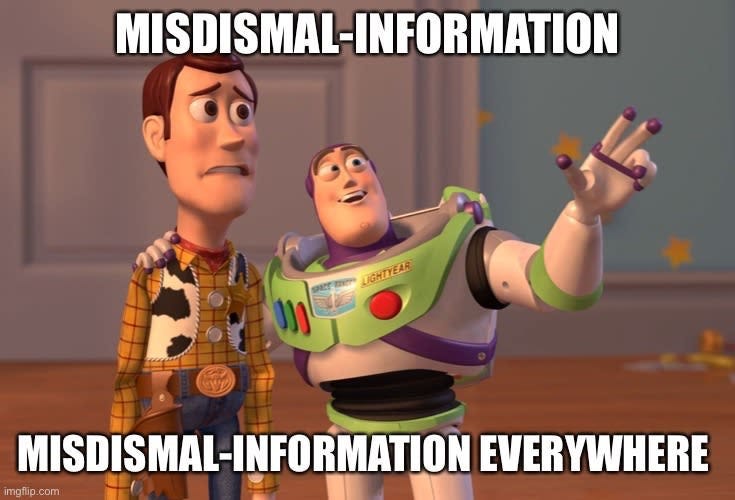
Free The Republic?
It turns out that the Maharashtra Police arrested 3 people, 2 of whom happened to be journalists with Republic TV. For all my ranting about Twitter trends, buried in work, I only noticed this when it happened to be trending somewhere near the top of Twitter’s list. At the time, it had around 115K tweets. So, stretching the (perceived) limits of Twitter’s Standard API I was able to pull 40K tweets related to the the hashtag FreeRepublicJournalist.
Prepare yourself, I am going to throw a lot of graphs at you.
There were approximately ~4700 unique tweets. The Top 1 % accounted for ~66% of them. Not odd by itself.

I then looked at the associated hashtags to create a TagCloud (if the image is too small, you can go over to the published version). Nothing too surprising from my perspective other than some belief that democracy was alive and well until now (Yes, yes, I vote).

Approximately 15K users participated. I looked at distribution of account creation timelines across the top 1%, 10%, 25%, 66% and all accounts. Consistently, around 23-27% of the accounts were created in the last 5 and half weeks. And that number goes up to 33-40%, if you include July as well. Think about that.




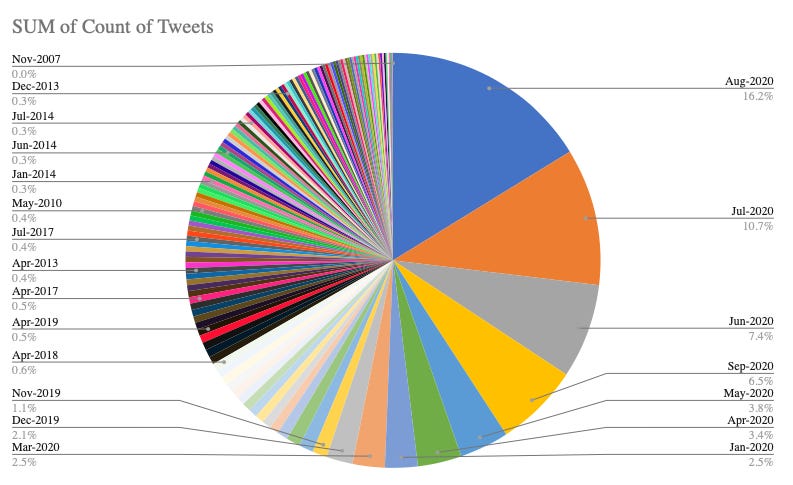
Paging Mr. Johnson

Wait, there’s more. I also looked into the top 5 most active accounts in terms of number of tweets and it was… something.

No. 1: Created within the last 3 weeks. Tweets mainly about the SSR case and shares a lot of Republic Links. 100% Retweets.

No. 2: Created < 3 days ago. Mainly tweeted about the SSR case, the Maharashtra government and Kangana Ranaut. <90% Retweets and some replies.
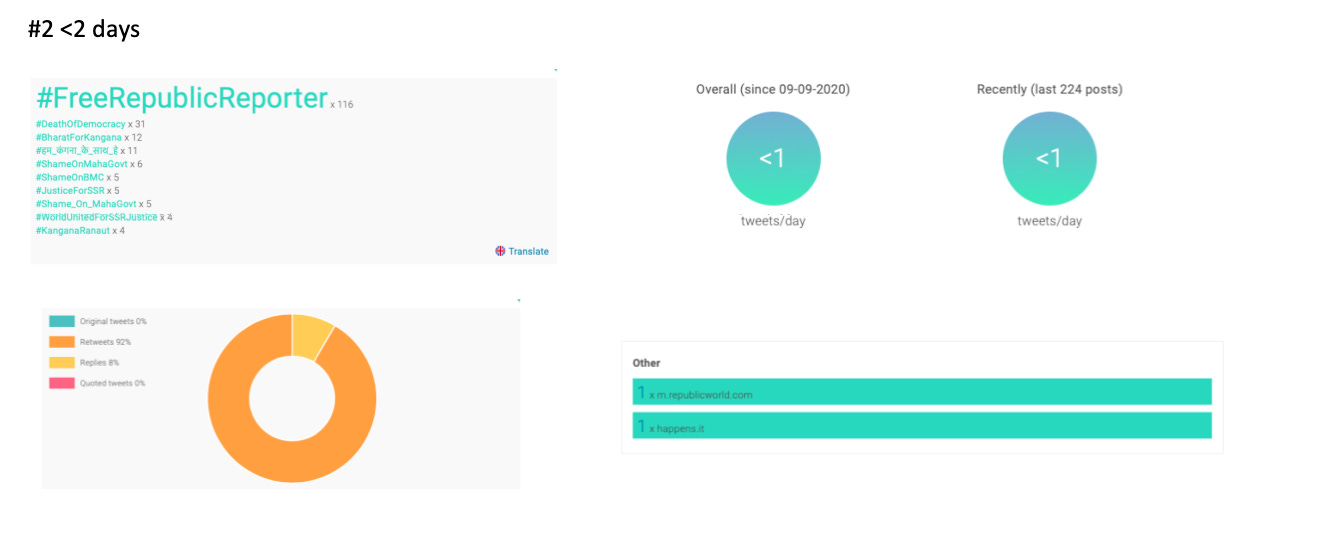
No. 3: Created in mid-July. Mainly tweets about the SSR case, lots of RepublicTV links (twitter and YouTube too). And manages to get to ~200 tweets per day.

No. 4: A veteran of sorts, with nearly 10 years on Twitter. Once again, recent activity has mainly been around the SSR case with a lot of RepublicTV links. And seems to average over 300 tweets/day.
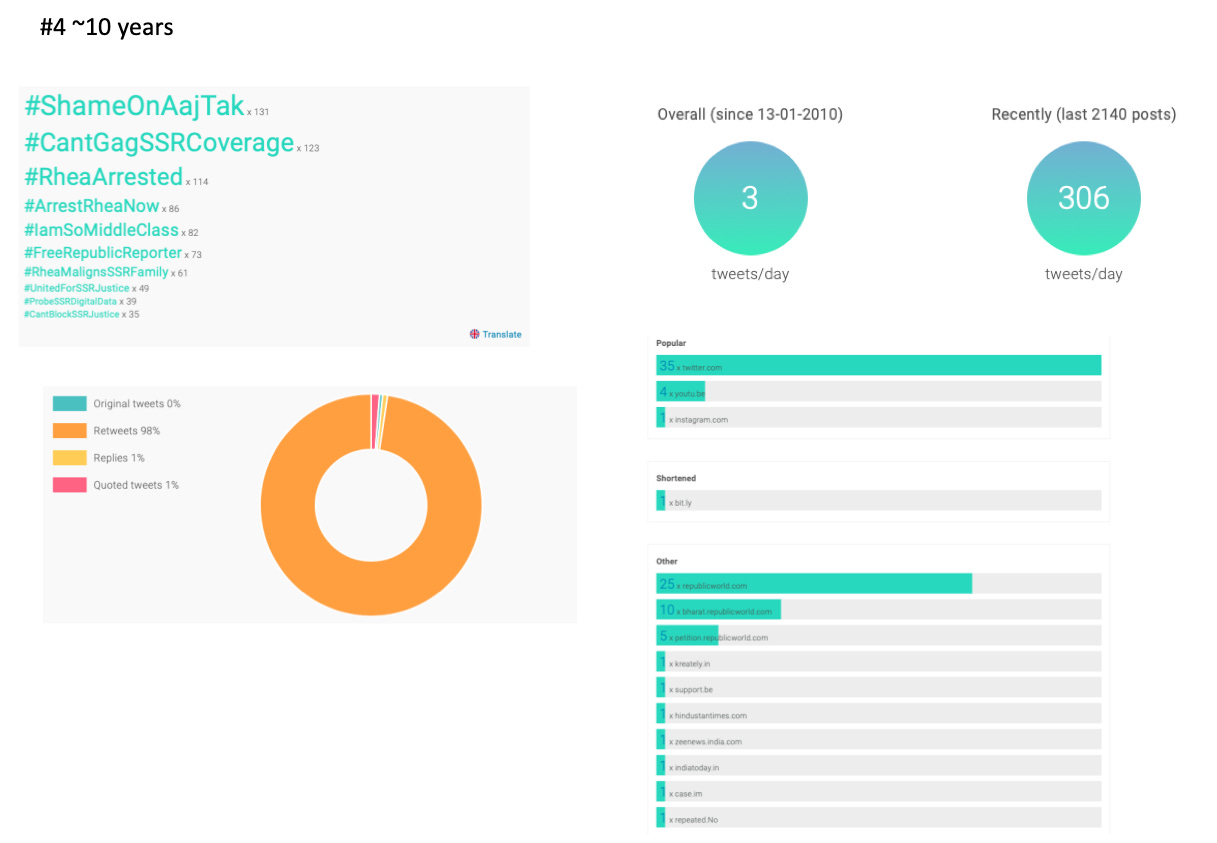
No.5: Been around for a little over 2 years. Has a varied set of interests including protecting democracy and Sudarshan TV, supports a Uniform Civil Code, wages and exams. Limited sharing of Youtube and RepublicTV links. And recently, seems to averaging over 700 tweets per day.

Rocky, over to you again!

Do I C Batman? NOPE. *If you didn’t get that - I’d recommend Edition 17. I spent a lot of time making that acronym up!*
Ok, see how little I trust you, so here’s a screenshot.

Ayushman Kaul of the DFR Lab also documented some of this motivation pertaining to the hashtag RheaArrested.


I am going to stop short of calling it a ‘bot-net’ because what is a bot-net anyway? But let’s just say they were “very motivated”.
To be honest, I’ve debated getting into this and considered taking the frog-in-the-well approach but as Amy Kazmin writes [paywall] in the context of the TV news serving “up a poitboiler to distract from national malaise”. It is hard not to consider the devastating impact this is having on the information ecosystem (as many other things already have). Not only for what we’re engaging in, but also the costs we’ll have to bear for ignoring other issues. Remember, the FAU-G guys had to come out and explicitly say…er…tweet that the game wasn’t Sushant Singh Rajput’s idea.
Last week, Sumant Raman, a commentator called on to discuss the Sushant Singh Rajput case in a primetime panel, sought to “place on record my deep disgust that on a day when our GDP has contracted by 23.9 per cent, on a day when China has intruded into our territory, we are discussing this issue”. He was reprimanded by the anchor. “If you find it so disgusting, go read the morning’s newspapers! . . .Don’t waste the nation’s time.”
And then there's this FT editorial[paywall again!] on ignoring conspiracy theories states (it is written in the context of QAnon):
The explosion in irrational beliefs stemming from online conspiracies and deep fakes is a very modern phenomenon in that it is enabled by technology. Yet the will to believe theories that impose a phoney sense of order on a chaotic world is as old as humanity. That is what makes such phenomena so difficult to counter.
Molly Mckew points out that this is impacting governance (again, this was said in a non-Indian context).
Conspiracy believers are very loud. They harass and they bully […] But we cannot let the bullies have the loudest say in this period of time when lives literally depend on it, and after we get past this public health crisis we still face crises in the economy, in education, and in about a thousand other things. Conspiracists and promoters of misinformation cannot be at the helm as we make these decisions and try to rebuild our nation. They simply don’t have the tools to cope.
Frogs, boiling water in pots and all that. You know what happens.
Meanwhile in India
Multiple news outlets fell for an account impersonating Rhea Chakroborty’s father after she was arrested. BoomLive’s Swasti Chatterjee uncovered the change to the twitter handle with a reply lookup on a 3 day old tweet. It’s not like different channels have fallen for this during the same long running story - oh wait.
IndiaTimes reports that there still some people who think COVID-19 is a hoax.
Remember the StanfordIO report from Edition 17? Well that (and Facebook’s announcement) is being used to make the case that, well, I’ll quote:
The Facebook report has revealed that in recent times, it has removed 453 Facebook accounts, 103 Pages, 78 Groups and 107 Instagram accounts, all of which were a part of one “network”, which were indulging in coordinated inauthentic behaviour. All of them were working, mostly in tandem, to spread fake news and anarchy in India.
The report indicated that the network operated across India and Pakistan without assigning any kind of split/distribution. Language matters.
An editorial in The Hindu called for more effective Fact-checking. No disagreement there, but the lede said this:”Only verified information should be put out in the public domain”. - > How do we define this ‘public domain’? Also, who does this ‘verification’? Also, also, - how?
Telegraph on the FIR’s against AltNews co-founder Mohammed Zubair.
Siddhant Chatterjee on what India can learn from the West on Debunking Disinformation.
Amidst this gap in State ability, intermediary responsibility, lack of trust, and coordination among constituent groups, this issue clearly signals the need for a hybrid, agile and collaborative approach that is multi-stakeholder in nature. A healthy mix of involvement, ideas and implementation is imperative. In this regard, India could benefit from an industry-led self-regulatory framework, coordinated and administered by the State. A model that can be adopted here is the European Commission’s approach to fighting online disinformation.
And Kabir Taneja writes about Indian deradicalisation efforts.
It is important to note here that India’s long tryst with facing terrorism has brushed away the usability and success of using online ‘counter-narratives’ as a tool; however, considering in most pro-IS cases in India the Internet was the first point of contact between individual and ideology, online counter-narratives, developed by localised sensibilities, remain a pertinent tool provided they are implemented effectively.
Sit-up, issue notice and arrest them all
Mamta Banerjee declared that she would publicly perform 100 sit-ups while refuting claims that there will be no Durga Puja. She also suggested that the police catch those responsible and punish them with sit-ups… while holding their ears.
The Mumbai police issued a notice to YouTube as it as “hapemering (sic) the image of Maharashtra government and the city police‘ by spreading objectionable videos and information related to the death of Bollywood actor Susant Singh Rajput.”. A YouTuber was also arrested.
The State Election Commission in Andhra Pradesh filed a complaint after an inauthentic message about a local body elections was attributed to the state election commissioner was circulated.
In Punjab, Chief Minister Captain Amarinder Singh directed the DGP to “crack down’ on ‘rumour mongers’. An FIR against LIP MLA was also filed.
Amarinder asked DGP Dinkar Gupta to monitor statements being issued by anti-India operators working from abroad and to register cases against all such people, wherever they might be located, who are found spreading rumours on social media and web channels. Amarinder directed the DGP to initiate the process of getting these entities banned in India.
The state had also launched a campaign to ‘counter rumours’.
Still with Punjab, a resident of Ludhiana was arrested for ‘offensive remarks’ against a government hospital. Testing in the state has been affected by rumours about organ trade.
Admins of “Social Media” groups will (continue to) be held responsible for information disorder. An advisory by Panchkula police said
“some people have used these to make fake messages viral which may cause unrest. For any circulation of such false messages both the sender and the WhatsApp group admin will be held responsible.”
Facebook-ed
Deeksha Bharadwaj’s write-up on Facebook’s Fact-checking partnerships. 8 partners and 11 languages.
Subhash Gatade has an interesting piece in NewsClick asking whether ‘Indian Democracy has been Facebooked’. It includes a throwback to Evgeny Morozov’s 2011 book - The Net Delusion: The Dark Side of Internet Freedom. It is rather amazing that this book came out around the same time as the Arab Spring was gaining steam.
Pranav Dixit on ~40 advocacy groups’s joint letter to Facebook asking for (no Indian groups as he points out):
An independent Human rights audit of its India operations
Putting Ankhi Das on a leave of absence and subsequent removal based on the outcome of the audit.
Engage transparently and make actionable commitments to human rights with relevant groups in India.
The Hard thing about Hard things is that they are… Hard?
Sorry, Mr. Horowitz.
Balance of Power
In Edition 17, I touched upon the balance of power in an “Nationalistic Internet” model. Daphne Keller published a twitter thread describing a spectrum of ways in which states seek to impose their will on platforms. The whole thread needs to be reproduced here.










Control + H
Nikki Ramirez describes the great migration of the great replacement from far-right groups in the US to the GOP.
Right wing media and the conservative establishments’ failure to stamp out racist, conspiratorial rhetoric from their midst has emboldened bad actors and legitimized a hateful ideology couched in white supremacy.
Hit Ctrl + H, and substitute something else for white supremacy. I have to say, we seem to be ahead of the curve.
QAnfluencers
Ben Collins and Brandy Zadrozny have been following QAnon pretty closely. So, here’s Ben telling us about a demographic shift (not replacement though) within QAnon.

Marc-André Agentino published a thread in early September about Pastel QAnon


If Decoupage becomes a QAnon thing, I will be very…very… angry 😡
Kaitlyn Tiffany had written about this back in August. “How the domestic aesthetics of Instagram repackage QAnon for the masses ”
And Lydia Khalil had written about this interplay between Influencers in general and QAnon in July.
The lifestyle influencers of today can serve as a gateway into extremist groups because of the cross-promotion of QAnon.
This has a number of implications for online platforms’ attempts to weed out dangerous content and label misleading posts. Because lifestyle and wellness influencers generate substantial revenue, have helped build social media businesses and have not generally intersected with extremist movements before, there is a concern that influencers will escape extremist content reporting procedures. Furthermore, influencer posts are more likely to reach a wider audience than extremist group posts as they are less scrutinised by social media mechanisms monitoring extremist content.
Can we call them QAnfluencers?
Parody or Information Pollution?
Before I go into specific types of content and morph into full-on killjoy, let’s go back a few years to this post by Claire Wardle in which she describes the 7 types of mis and disinformation
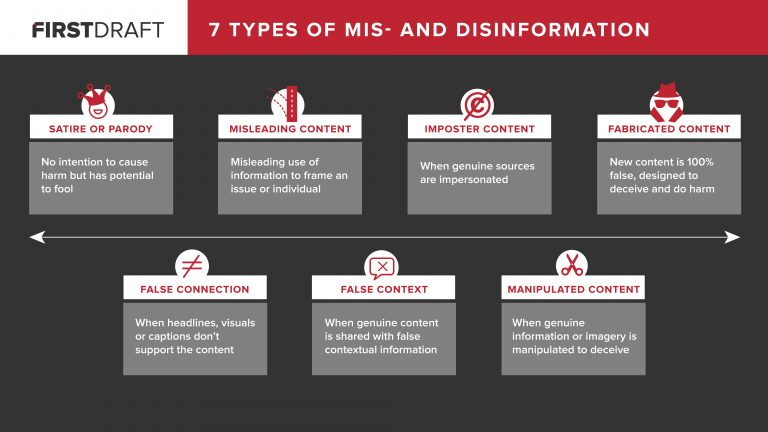
She further maps them across 8 different motivations.
Poor Journalism,
Parody, to Provoke or ‘Punk’,
Passion,
Partisanship,
Profit,
Political Influence or Power
Propaganda.

Next, let’s bring in Poe’s Law (possible paywall):
If you’ve spent much time on social media, you’ve seen this tactic before: someone trying to slip out of their rhetorical bind by claiming that their offending statement had been a joke, and that you’re just being hypersensitive. That thing where someone wears irony as a defense, hiding their true motives? What is that?
That, friend, is Poe’s Law: On the internet, it’s impossible to tell who is joking. In other words, it’s the thinking person’s ¯\(ツ)/¯. But Poe’s Law isn’t only useful as a defense against pearl-clutching reactions. It’s also a diagnosis of exactly how the troll mentality has weakened internet culture.
And
Poe’s Law doesn’t end online, either. “People talking about ‘spin in the era of Trump’ and ‘post truth’ don’t talk about politics in terms of Poe’s Law,” Phillips says. “But it’s there, whenever you’re not sure if you should be mad or just roll your eyes.”
Now, for the next 45-60 seconds shed your political affiliations (I know this isn’t easy but try it - you can go back after 60 seconds).
With me so far? Ok, now look at:

(Link)
And think about what they achieve. A few laughs? Antagonising someone you don’t link? Rinse… Repeat.
Also, pretty rich coming from someone who likes to pun various titles.
The Brain and our Social Dilemma/Disaster
Robert Roy Britt in Elemental Why your Brain Loves Conspiracy Theories.
What is a conspiracy theory?
“A conspiracy theory,” Uscinski says, “is an accusatory perception in which a small group of powerful people are working in secret for their own benefit against the common good and in a way that undermines our bedrock ground rules against widespread force and fraud, and that perception has yet to be verified by the appropriate experts using available and open data and methods.”
There’s very little difference in conspiratorial tendencies based on liberal or conservative leanings, and likewise very little between Democrats and Republicans. That’s not to say ideology doesn’t play a huge role in conspiracy thinking — it just isn’t a good predictor of a person’s tendency to believe.
And one of my favourite bits:
“One person’s conspiracy theory is another person’s conspiracy fact,” Brotherton writes. “Any attempt to draw a neat line between true and false conspiracies is doomed to endless debate about what evidence is compelling, who the real experts are, and whether they can be trusted.”
There was another bit in the article that I want to build on”
“There’s an entire movement of anti-science, contrarianism, and hucksters who thrive on attention/clicks,” says Ryan McNamara, PhD, a research associate at the University of North Carolina, Chapel Hill. “They’re amplified while many of us in infectious diseases are relegated to being on an equal plane with them.”
@Adico writes about the polarisation between Traditional Media and Anti-Science sources.
The polarization is telling from two angles:
1. The sources shared in the anti-science groups tend to be more “alternative” media based. While there were some shares of The Daily Mail articles and from Australian or even U.S. mainstream outlets, RT — alongside several other anti-vax, conspiratorial outlets and YouTube channels — were the leading sources for anti-science groups. More mainstream media (from right and left), has been more successful with pro-science groups.
2. There is significant overlap between political leanings and attitudes towards a Covid-19 vaccine. Liberal-leaning groups appeared next to groups such as “March for Science” and “Fauci Fan Club”, whereas groups portraying themselves as pro-Brexit, pro-Trump, pro-Tea Party shared more anti-science sources.

And since we’re on polarisation:
Netflix’s Social Dilemma which may as well have been called Social Disaster.
Yael Eisenstat’s TED talk on how Facebook profits from polarisation

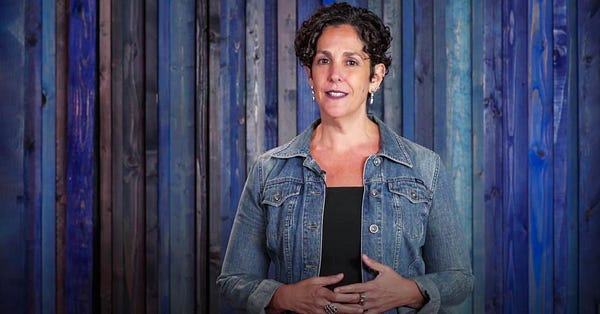
A Kevin Roose thread referenced a post by Mark Zuckerberg about the performance/engagement that ‘prohibited content’ receives. There was no link though, I’m still looking for the source.


Jeremiah French on Internet Disgust and Disinformation:
In this attempt at a more perfect nation, I’d like to think that filtration is just a trend that we’ll eventually even out. But until then, we’re at least comforted by some good news: according to The Hidden Tribes of America, a yearlong study in 2018 to understand polarization and tribalism by the nonprofit More in Common, found that the polarized split is more a perception than a reality, as 77% of their study fit into an Exhausted Majority who are fed up with polarization and believe our country can come together to solve its problems.
Around the world
Information Operations
Joshua Yaffa has an absolutely chilling piece in The New Yorker. Again, though written into American-Russian some lessons apply. Now, the TL:DR is that countries have to work on fixing their domestic information ecosystems if they are going to be resistant to interference but there are some additional key elements
The distinction between Foreign and Domestic Disinformation is now irrelevant
Relatively open-societies can end-up closing themselves in off as a reactive response.
It is important not to overstate the impact of influence operations, often - that is where the real harm occurs either through amplification or pushing misconceptions.
And the part that struck me the most, was a section on Operation Denver - something I can see happening to us in this atmosphere of mistrust.
Perhaps the best-known K.G.B. active measure of that period—and the most resonant today with what the World Health Organization calls the “infodemic” surrounding COVID-19—was a disinformation campaign known as Operation Denver. The K.G.B., along with the East German Stasi, propagated false scientific research and planted press reports to suggest that H.I.V. did not leap from primates to humans in Africa but, rather, had been cooked up at a U.S. Army laboratory in Fort Detrick, Maryland.
But Rid points out that in the U.S. the most vociferous propagators of the notion that H.I.V. had American origins were gay-rights activists and the African-American press—communities that did not need the K.G.B. to convince them that their own government could treat their health and lives with disregard. In the early eighties, the Reagan Administration was callously unconcerned by the toll that the virus was taking on gay men. And the chilling precedent of the decades-long Tuskegee syphilis experiment, to take one example, demonstrated the state’s willingness to treat African-Americans as unwitting guinea pigs in secret medical experiments.
Oh, and the Department of Homeland Security released a bulletin which mentioned that “Russian actors are spreading “unsubstantiated allegations” that former Biden is of “ill-health,””
Seth Rosenblatt in Dark Reading on Strategic Cyber Warfare. Quoting Grugq’s keynote at Disclosure Conference, the article assets that K-pop band BTS has ‘cyber power’ [context - Trump’s rally].
ASPI report on Falun Gong related activity targeting Australians on Facebook.
Shaping conversations
ASPI’s report on TikTok and WeChat “curating and controlling global information flows.” (Aside: Paul Mozur on WeChat being the main powerhouse for China)
More recent examples of apparent censorship—including posts tagged with BlackLivesMatter and GeorgeFloyd—have been explained away by TikTok as the result of a ‘technical glitch’.Our research suggests that many of these cases were most likely not aberrations, but the side effects of an approach that ByteDance, TikTok’s owner and operator, has used in an attempt to avoid controversy and maintain what it considers to be an apolitical stance as it grows a worldwide audience. But the very nature of TikTok’s targeted global censorship isn’t apolitical; in fact, it makes the app a politically powerful actor.
The report includes two Indian TikTok users (Ajay Barman and Saloni Gaur) who believe they were shadow-banned/censored by TikTok.
Also see Fergus Ryan’s thread:


And also…
New Zealand has been featuring a lot lately. Jacinda Arden criticising criticising misinformation against Labour policies. There are also concerns that a far-right party will use a TV debate to air conspiracy theories. Or for us in India, what we call ‘every day’.
Still with New Zealand, Kate Hannah runs through the COVID-19 related false information in country.
The Covid-19-specific conspiracy theories observed in New Zealand, especially since August 13 2020, are largely linked to established conspiratorial narratives about the presumed intent and motivation of scientists and science. These are conspiracies related to the virus’s origins and to speculative cures. The other key group of stories which are amplified now relate to the behavior and motivations of governments, nation-states, leaders, and organisations like the United Nations or the World Health Organisation.
Finally, some news about Brazil’s anti-disinformation law. It could be voted on by the end of this year.
DemocracyWatch goes around the world:
‘Fake news’ laws have seen journalists across the world locked up, while misinformation has run amok, with conspiracy theories and COVID-denial bedding in. In Europe and the US, there have been mass protests against lockdown measures, while the police continue to kill people in Kenya under curfew laws.
They skip past South Asia. Since the lede pertains to a second wave - maybe that’s why. We’re possibly still in Wave 1. 🤷♂️
In an interview with Vanity Fair, Ali Soufan refers to Ameria’s post 911 actions as disinformation.
A Draft DHS report in the U.S., refersto white supremacists as the most persistent and lethal terror thread in the US.
TikTok is joining EU’s code of conduct against hate speech. The EU has also urged Facebook, Twitter and Google to do more to fight information disorder. Get in line, EU
Some Iranian lawmakers want the military to control the Internet. Great!
Austria seems to be working on its version of NetzDG


Solutions… or something.
See, once in a while I try to give you solutions too.
Ben Nimmo’s 4-Ds to help spot Disinformation: Dismiss, Distort, Distract and Dismay.
A study from the University of Copenhagen which claims to establish whether a headline is true or false by tracking eye-movement. It isn’t open-access. I guess this falls in the something category for now
From Malaysia - Media Literacy is key to ‘healing the fake news epidemic’. Can we please stop calling in fake news


This would have already happened by the time this newsletter goes out. So here’s a link to their study on WhatsApp Fact-checking in India. It’s worth trying, if for nothing else other than to say -
I Don’t Think That’s True, Bro!
Bonus Content
You’ve done well to get so far, let’s give your eyes some rest and include some podcasts.
On Point: The Threat to U.S. Elections. with Nina Jankowicz, Jack Delaney and Miles Taylor
A platform-by-platform prescription for treating the disinformation disease with Joan Donovan
Why We’re Being F*cked on Disinformation with Cathy Reisenwitz




